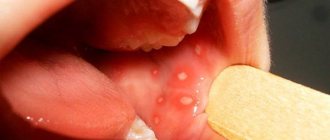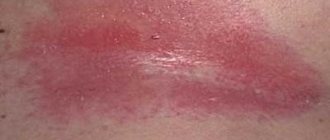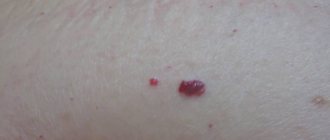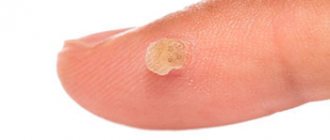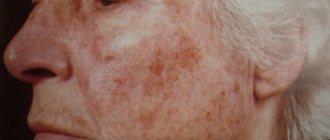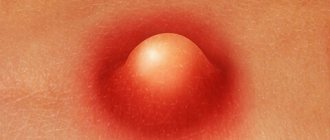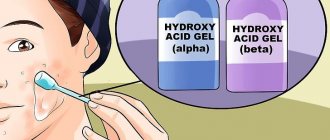Medical research has long confirmed that the integrity and smoothness of the epidermis is an indicator of a person’s overall health. Therefore, we may be bothered by such unpleasant phenomena as red spots on the head under the hair.
Dermatological manifestations may be accompanied by sensations of dryness, irritation, itching, excessive exfoliation of skin scales, and apolecia. This problem is more noticeable in males due to short hair.
Allergic reaction
Red spots on the scalp caused by an allergic reaction occur due to the increased sensitivity of the dermis to certain irritants.
- citrus and other products;
- chemicals contained in shampoos and other personal care products;
- animal hair, pollen;
- with active sweating on the head.
The allergic form of dermatosis on the head develops due to hereditary predisposition, endocrine pathologies, dysfunction of the gastrointestinal tract or severe stress.
An allergic reaction usually occurs almost immediately after contact with the irritant. In this case, the following phenomena are observed in men and women.
- intense itching;
- redness of the scalp;
- peeling of the skin.
Important! The allergic reaction often occurs as seborrheic dermatitis. Therefore, treatment begins only after identifying the causative factor.
The most incredible way to get my hair back!
This is just a DISASTER ! And after all, my hair did not start falling out in one day, but systematically - day after day I watched how the hair left my head: while combing, washing, even while sleeping. (read more…)
Treatment
At the beginning of treatment of an allergic reaction, it is necessary to eliminate the exposure to the irritant. The treatment regimen is selected taking into account the cause of the appearance of red spots on the head.
- When the first signs of an allergic reaction appear, it is recommended to take antihistamines: Claritin, Zodak, Erius and others.
- For the symptomatic treatment of allergies, ointments that suppress the inflammatory process are used: tar, ichthyol and naphthalene.
- In severe cases, corticosteroid-based ointments are used to treat the skin.
- Entrerosorbents are used as an adjunct to drug therapy. These drugs help remove toxins from the body, thereby reducing the intensity of the allergic reaction.
- Treatment of the pathological condition is recommended to be supplemented with a specialized diet, which has a positive effect on the functioning of the digestive system in adults and children.
Red skin under hair: causes
Redness under the hair can suddenly happen to anyone: women, men and even small infants. There are quite a few factors that can provoke such symptoms, and among them:
- Seborrheic dermatitis.
- Psoriasis.
- Allergy.
- Sunburn.
- Lichen.
- Excessive dry skin.
- Various vascular problems.
- Parasites (lice).
- Pigmentation, etc.
It is quite difficult to independently determine which factors led to the occurrence of unpleasant symptoms. When faced with red spots on the head, it is better to seek advice from a dermatologist or therapist than to engage in self-medication and self-diagnosis.
Dandruff and redness due to dermatitis
Seborrheic dermatitis is a rather insidious chronic disease, which is accompanied by the appearance of foci of inflammation on the skin rich in sebaceous glands. The main reason for its development is the activation of a special fungus, which is normally always present on the surface of the body, but when exposed to certain factors it begins to multiply uncontrollably.
Seborrheic dermatitis of the scalp is characterized by:
- Progressive and slow course.
- Severe itching.
- The appearance of areas of redness on the skin that have fairly clearly defined boundaries. On their surface you can see small fatty scales.
- Hair loss due to damage to the hair follicles by pathogenic fungi.
- Possible formation of bubbles that tend to form groups.
Treatment of seborrheic dermatitis should be comprehensive. Patients need to change their usual lifestyle, switch to dietary foods, and normalize the functioning of the digestive tract. At the same time, you need to use different shampoos, masks and balms recommended by your doctor. Systemic antifungal medications may be necessary.
Quite often, seborrheic dermatitis subsides and even disappears completely after switching to a completely healthy lifestyle and eliminating all kinds of stress. However, the disease can recur.
Peeling and plaques in psoriasis
Psoriasis is a non-infectious disease, the exact causes of which are still unknown to scientists. Sometimes the first manifestations of such a disease can be localized precisely on the scalp. The essence of this disease is the sudden accelerated renewal of keratinocyte cells, which rise above the normal level of the skin, forming psoriatic plaques. Such reactions are accompanied by the development of an inflammatory process, since the body perceives the plaque as something foreign. A unique impetus for the development of psoriasis can be a malfunction of the immune system or severe stress. The main manifestations of this disease:
- Rocky spots with uneven contours. They may have a red-violet color.
- Drying of the scalp.
- The appearance of flaking, reminiscent of dandruff. Subsequently, entire foci of the disease form - psoriatic plaques.
- The appearance of burning and pain in the area of the rash.
- The appearance of cracks during a common process or scratching (injuries) when trying to remove scales.
It is currently impossible to completely get rid of psoriasis. However, modern medicine offers patients with this diagnosis medications that can control keratinization processes, suppress inflammatory processes and improve the appearance of the skin. At the same time, you must adhere to a diet and a proper lifestyle.
Allergy to the scalp
Symptoms of allergic reactions can appear in different parts of the body. True, on the scalp they usually occur when such areas come into direct contact with allergens. Their role can be played by care products (shampoos, balms, masks), styling and coloring of curls. You can suspect the development of an allergic reaction by:
- The appearance of red spots. Sometimes bright areas of hyperemia appear throughout almost the entire skin under the hair. And in some cases, their boundaries may even extend beyond the area of hair growth.
- Itching and burning sensations.
- The appearance of the described symptoms shortly after contact with the allergen (or directly during it, if we are talking about paint).
Sometimes skin allergies under the hair can lead to pimples (red and itchy), dandruff, and even hair loss. The main way to treat this condition is to avoid any contact with the allergen. And to suppress unpleasant symptoms, you can use any antihistamine.
Sunburn
Sunburn can affect the skin on different parts of the body. And when going to the beach, most of us carefully use safe tanning products. But at the same time, few remember about the head. If you don't cover it with a hat or scarf, you can end up with a pretty severe burn. Most often, such a nuisance happens:
- People who have recently cut their hair, resulting in hair-free skin, are completely unaccustomed to the sun.
- For people with a clear parting.
A sunburn on the head manifests itself in the same way as a burn on the body - it hurts and turns red. It is even possible for bubbles to form. When faced with such symptoms, it is worth cooling the skin with cold water or a compress of green tea. Afterwards, you can carefully treat the skin with a medicine for burns, for example, Panthenol.
Ringworm - smooth pink marks
There are several types of lichen that can occur on the scalp. All of them are caused by fungal organisms and can affect other areas of the body. The main manifestation of lichen on the head:
- The formation of a spot that is different from other healthy skin. The color of such an area can be different - pale pink, yellowish, red.
- The edge may be clearly demarcated, red and crusty.
- Ringworm causes an unpleasant itching sensation, but not too pronounced.
- The surface of the spot peels off, and the mark itself tends to increase in size.
- The hair in the area where lichen appears breaks off, only sharp short stumps are visible.
Basically, treatment of lichen involves the use of various antifungal drugs - in local form (gels, ointments, balms, shampoos) and in the form of tablets. At the same time, it is important for patients to adhere to a diet and especially carefully follow general hygiene recommendations, since this disease is quite contagious.
Red circles on legs and hair loss
Various types of lichen can spread to other areas of the body. In particular, they can spread to the skin of the legs. Mostly, such manifestations of the disease are localized on the inner and front side of the thighs, but there may be exceptions. The hair at the site of the lesion does not fall out, but breaks off close to the surface of the skin, although it may seem to those with light hair that they completely disappear. But if you arm yourself with even an ordinary magnifying glass, you can see the rest of the hair shaft.
Don’t think that lichen on your legs will go away on its own. This is a rather insidious disease that requires targeted treatment under the supervision of an experienced dermatologist.
Eczema: skin is red and itchy
Eczema is another unpleasant dermatological ailment that is not dangerous from the point of view of transmission to healthy people, but can lead to the appearance of very unpleasant changes on the scalp:
- Spots of different sizes and shapes with clear contours. It is focal redness of the skin that is the first manifestation of the disease. They may be a little itchy and cause a feeling of dryness and tightness.
- Small nodules of a yellowish-pink color, prone to merging into flat plaques. Subsequently, scales may appear on them, becoming covered with sebum and acquiring an unpleasant dirty yellow color. With this pathology, the skin becomes very oily.
- Papules filled with serous fluid. They tend to break through and form large wet areas.
Eczema causes noticeable itching and can progress beyond hair growth. If not treated correctly, it can become chronic. Therapy for such a disease is carried out exclusively under the supervision of an experienced dermatologist and is comprehensive.
Severe dryness
Sometimes reddish spots appear on the scalp when it becomes noticeably dry. Something like this can happen:
- At the initial stage of development of various dermatological diseases.
- With severe fluid deficiency in the body.
- Not using the right scalp care products.
- When the indoor air is very dry.
- With a lack of various nutrients in the body.
If the skin dries out, flakes may appear on it - dry dandruff. It is also possible to experience discomfort, a feeling of tightness and itching. The hair may begin to fall out. To cope with the problem, you need to adjust your drinking regime and nutrition, take a course of vitamins and organize a suitable microclimate in the room, for example, purchase a humidifier and actively use it during the heating season. And most importantly, it is better not to scratch the skin, since if you injure your nails, there is a risk of encountering an infection.
What if red dots appear?
Single red dots on the scalp can appear as a result of microtraumas, for example, when creating a complex hairstyle or careless use of a comb. But in addition, such a symptom can occur as a result of:
- Vascular diseases.
- Parasite bites.
Any new growths on the skin should be considered as a reason to take a closer look at your own health and, preferably, consult a doctor.
Vascular diseases
Sometimes red dots, a couple of millimeters in size, appear on the scalp. They do not cause any discomfort, are not accompanied by changes in the surrounding skin and do not cause hair loss. Such points can be essentially small vascular tumors - capillary hemangiomas. In general, they are quite harmless and are not prone to malignancy. But doctors strongly recommend monitoring them. If such tumors tend to actively grow, it is better to play it safe and consult a dermatologist-oncologist.
Parasite bites
Even residents of modern megacities may well develop pediculosis. Lice are easily transmitted from person to person, despite careful personal hygiene. And their activity can be suspected by:
- Severe itching that forces you to scratch the skin.
- Red stinging spots under the hair and behind the ears.
- The appearance on the hair shafts of white, tightly attached tiny capsules - nits (lice eggs).
Diagnosing pediculosis is not at all difficult. And modern advances in pharmaceuticals will help cope with it in the shortest possible time. You just need to process the curls twice in accordance with the instructions on the package, comb out the nits and take care of the cleanliness of the bed, comb and other similar items.
Peeling in a child
The appearance of flaky spots on a child's head can cause a real panic attack in parents. But doctors say that this phenomenon is quite common and is of an allergic nature. Pediatricians classify peeling as gneiss; it is essentially seborrheic crusts consisting of skin scales and secretions of the sebaceous glands. Sometimes crusts appear already in the first days of a baby’s life, and most often disappear without a trace until he reaches one year of age.
Gneiss does not pose any threat to the life of the baby, does not bother him, and does not require targeted treatment (except for particularly strong expression). However, such spots indicate a child’s predisposition to allergic reactions, which must be taken into account.
It is worth noting that red, itchy and flaky spots in children can also appear for other reasons described above. In particular, even an infant can be diagnosed with lichen, and older children can be diagnosed with psoriasis or eczema.
Seborrheic dermatitis
The first signs of pathology occur when a fungal infection parasitizing the scalp becomes active. This is what they lead to.
- weakening of immune defense;
- endocrine pathologists and hormonal imbalance;
- severe stress.
Note! Seborrheic dermatitis occurs due to the active secretion of skin secretions caused by the abnormal structure of the sebaceous glands of the head.
The disease causes redness of certain areas of the skin, the surface of which begins to peel off over time, pink spots and dots appear on the back of the head and other parts of the body. The course of the pathology is accompanied by intense itching and, in rare cases, pain. Seborrheic dermatitis worsens due to poor nutrition.
In a child or teenager, the disease can cause rashes in the form of acne. Such neoplasms occur against the background of active sebum secretion, which closes the hair follicle. As a result, the latter becomes inflamed. This leads to acne.
Treatment
For seborrheic dermatitis, complex treatment is carried out, including the use of the following drugs.
- Antihistamines and hyposensitizers. These medications are used for symptomatic treatment. The first group of drugs (Clemastine, Chloropamine) relieves itching and restores skin color. Hyposensitizing agents (sodium thiosulfate, calcium gluconate) are injected directly into muscle tissue or veins.
- Antifungal. Medicines in this group (Clotrimazole, Fluconazole) stop the growth and reproduction of fungal microflora in the scalp. Antifungal drugs are used in the form of ointments (for mild forms of the pathology) and tablets (for severe forms).
- Glucocorticosteroids. Prescribed when an inflammatory process is detected. Glucocorticosteroids (Hydrocortisone, Beclomethasone) for seborrheic dermatitis are used in the form of ointments.
- Keratolytic. Used to remove dead skin parts. The group of keratolytic drugs includes medications including zinc, salicylic acid, and urea.
In case of secondary infection, drug therapy is supplemented with tetracycline antibacterial drugs.
If seborrheic dermatitis relapses, it is recommended to abandon the use of usual cosmetics in favor of specialized shampoos or shower gels that suppress the activity of fungal microflora.
Eliminating symptoms
If the cause of a rash on the head of a child or an adult is excessive dryness of the skin or dandruff, then there are ways to get rid of the problems at home. The most effective and proven traditional medicine recipes are listed below.
However, before using them, it is recommended to make sure that there is no allergic reaction to any of the components of the products:
- To eliminate seborrhea, use a decoction of plantain with the addition of calendula. You will need 40 g of each component, which is poured into 300 ml of boiling water. Infusion is carried out in a thermal mug or thermos. Use every time after washing your hair. Use it to wipe away spots that appear on the scalp;
- To eliminate severe itching, use sage lotions. To prepare, you will need 10 g of dry plant material, which is poured with 300 ml of boiling water. The broth is kept on the fire for 5 minutes and after filtering and cooling, lotions are made. You can also add a small amount of honey before use;
- olive oil mask. The simplest recipe to eliminate red spots on the head caused by dry skin. You will need to rub natural olive oil into problem areas on the scalp. To enhance the effectiveness of the oil, it is recommended to wear a shower cap and leave the mask on for at least 1 hour. You can wash off the product with shampoo, preferably with a moisturizing effect;
- relieves symptoms well and eliminates the manifestations themselves with infusions and decoctions of burdock root, St. John's wort and elecampane. These plants can be used either independently or in combination with each other. In the latter case, you need to take the same amount of each ingredient and pour 300 ml of boiling water. It takes 8-10 hours to infuse. The infusion can be prepared before bed, left overnight and used in the morning. The product can be used if spots appear on a newborn. You need to wipe your scalp throughout the day.
Conclusion
To quickly achieve the desired effect and get rid of the problem, it is best to consult a doctor as soon as possible. It is also recommended that you continue to monitor your health and the health of your child more carefully and prevent the influence of negative factors that provoke the appearance of rashes.
Psoriasis
Psoriasis is a chronic inflammatory skin disease. It is extremely difficult to establish why pathology develops in a particular patient. It is believed that factors that weaken a person’s immune system can provoke a relapse of the disease.
- infectious, viral and other diseases;
- severe stress;
- prolonged exposure to direct sunlight (useful in small doses);
- taking medications and more.
By the way! It is believed that the appearance of psoriasis is due to heredity.
After an exacerbation, the pathology goes through several stages of development, each of which is characterized by certain symptoms.
- itching and redness of the dermis, over time the skin itches more and more;
- peeling of the skin;
- the appearance of large spots covered with white flakes (dead tissue);
- cracks and abrasions on the head.
The elasticity of the skin in the problem area decreases, as a result of which the dermis is easily injured.
Treatment
Psoriasis requires an integrated approach to treatment. Therapy of the disease involves the use of:
- corticosteroids and cytostatics (in severe cases);
- antihistamines;
- sedative and hyposensitizing drugs;
- vitamin complexes and immunomodulators.
The use of these drugs is intended to relieve symptoms characteristic of psoriasis and increase the duration of the remission stage. However, it is impossible to completely get rid of the pathology. In case of secondary infection, treatment of psoriasis is supplemented with local antibacterial drugs.
A child has yellow crusts on his head - dandruff or disease?
The appearance of yellow crusts on the baby's head makes every mother worry.
But don’t worry, you just need to understand this problem and understand that this is not a disease, but the formation of a tiny organism.
So, let's look at the reasons for the unusual symptoms.
Seborrheic crusts are a type of dandruff.
In an adult, its appearance is provoked by dry skin on the head; in children, it appears due to excessive secretion and accumulation of sebum.
https://www.youtube.com/watch?v=2Zub-kl9fYc
The localization of the crusts is fronto-parietal, but since the sebaceous glands are located throughout the body, their appearance can be found on the eyebrows, behind the ears, on the temples and even on the cheeks of the toddler.
When a lot of scales accumulate, a crust forms and looks like a yellow cap. The common people called this problem “baby’s cap.”
Causes of crusts
The appearance of crusts is primarily due to the physiology of the baby.
His body is at the stage of improvement, so the sweat and sebaceous glands do not work smoothly, which promotes the growth of yeast, which every person normally has and is part of the microflora.
For adults, the appearance of seborrheic dermatitis is an alarming signal, but in a newborn it is a variant of the norm.
If your baby has reappeared after the crusts have disappeared, you should immediately consult a doctor.
Also, the appearance of yellow formations can be caused by a number of factors:
- Dietary disorders of a nursing mother or incorrectly selected formula.
- Overheating of the baby or frequent wearing of a cap. As a result, the child sweats a lot, the discharge remains on the baby’s head and mixes with sebum.
- Allergy to products used in infant hygiene. As a result, irritation and rashes appear, the skin becomes dry, which leads to the formation of more and more scales.
- Frequent hair washing removes the oily layer covering the baby's body. The sebaceous glands, trying to protect the body, begin to work more productively, which leads to increased production of sebum.
Symptoms
Seborrheic formations have a number of characteristic features:
- The mother notices the first crusts already at 2-3 weeks of the baby’s life;
- scales appear not only on the baby’s crown, but also on the temples, forehead, eyebrows, and behind the ears;
- the formations are yellow or gray in color, have a greasy texture, and their accumulations resemble flakes that have covered the head;
- Normally, these crusts should not bother the baby;
- the scales easily stick to the comb and hair, especially after they get wet;
- crusts should not leave damage on the baby's skin.
If the baby behaves restlessly and at the same time has pustules, abrasions, scratches, then you should definitely consult a specialist.
Treatment
Treatment of seborrheic crusts can be carried out at home independently, without the use of medications.
You can also use special products designed to eliminate scaly formations after consulting a pediatrician.
Pediatric doctors most often prescribe foams or shampoos for infants.
The product should be applied to areas covered with crusts, slightly foamed and massaged into the skin for three to four minutes, after which you can bathe the baby and pat the hair dry with a towel.
The most popular drugs for seborrheic crusts are shampoos: Kelual D.S., Nizoral, Friederm tar and others.
Sometimes, with large areas of damage, shampoos may not give the desired result. In this case, after consultation, the doctor may prescribe treatment with ointment for seborrheic dermatitis. Thanks to its texture, the product is well absorbed and effectively fights dry crusts.
Modern manufacturers have also developed a cream for scalp crusts, which acts quickly and relieves the baby of scaly formations in the shortest possible time.
How to comb out crusts from the scalp of infants?
Parents often do not want to wait for the scabs to come off on their own. In this case, a mechanical method of removing scales will come to the rescue.
Combing out crusts takes place in several stages:
- Hydration. Two hours before bathing, apply a small amount of oil to the affected area of the head. You can use sunflower, olive, almond, Vaseline or any other, the main thing is that there are no allergic reactions. Apply carefully, do not press too hard. While the mixture is absorbed, you can wear a hat or cap, this will help protect against stains. After the oil softens the crusts, the cap should be removed. Next, you need to take a soft brush and massage the baby’s skin, paying special attention to places where there is a large accumulation of “flakes”; you need to move in different directions so that the scales peel off well.
- Bathing. In order for the oil to be washed off better, you need to lather your hair with shampoo and leave it on while your baby is bathing. Next, the product needs to be washed off. At the end of the water procedures, you should lightly blot the baby’s hair with a towel, and under no circumstances rub it. If the temperature in the apartment allows the child’s hair to dry on its own, then you should not use a hairdryer. It will only make things worse by drying out the delicate skin.
- Combing. After bathing, the softened crust needs to be combed. It is better to choose a comb from natural materials, with rounded ends, so as not to injure the baby. After all the manipulations, the scales should be easy to remove and stick to the brush, from which they should be removed immediately, and only then continue combing. The crusts can get tangled in the hair; they should also be carefully picked up with a comb and removed.
If the child begins to protest, try again next time, since you won’t be able to get rid of the crusts in one go.
This procedure can be performed no more than twice a week. If you do not use detergents, then softening and combing can be done at least every day until the seborrheic formations are eliminated.
Do not try to pick off scales with your fingernails. This can damage the baby's delicate skin and cause him pain.
Crust care
To prevent crusts from constantly growing, you need to properly care for them:
- do not ignore the appearance of seborrheic crusts in infants;
- according to doctors, scaly formations must be treated;
- moisturizing the scalp with special creams and combing can prevent dandruff from drying into a hard crust;
- using oil for steaming will prevent scales from growing;
- Observance of the temperature regime will prevent the appearance of new formations.
When will the crust on the baby's head go away?
If seborrheic dermatitis is uncomplicated, it usually goes away on its own by 8-9 months of the baby’s life with proper care of the baby and does not require the use of special means. But you should understand that each child is unique, and everything depends on how quickly the work of the little body normalizes.
Why doesn't it work?
Taking the necessary tests and a doctor will help determine exactly what caused the persistence of seborrheic crusts in the baby.
The recovery process is individual for each baby, and therefore many factors influence the time it takes for the scales to disappear:
- whether parents properly carry out the baby’s hygiene;
- how often they wash and what products they use;
- whether the problem is being treated and eliminated;
- whether there is an allergy in the baby’s body;
- How does a nursing mother eat?
- if the baby is artificial, then how correctly the mixture was chosen.
Failure to comply with at least one of the above factors can cause the formation of new crusts and various complications, as well as an obstacle to eliminating old ones.
Thus, seborrheic crusts in infants are normal and do not pose any danger. Only their unaesthetic appearance forces many mothers to take measures to eliminate the problem. The main thing in this matter is regularity and patience, then success is guaranteed.
Source: https://momjournal.ru/zdorove-rebenka/detskie-bolezni/u-rebenka-na-golove-zheltye-korochki.html
Lichen
Lichen, like seborrheic dermatitis, occurs due to the activity of fungal microflora. Depending on the type of pathology, it develops after contact with animals or other carriers of the pathogen, as well as under the influence of factors that weaken the immune system.
A characteristic sign of lichen are spots of various sizes and shades that appear on the scalp. In the problem area, thinning and hair loss occurs. As the disease progresses, a person is bothered by itching and rash.
Treatment of lichen is carried out by treating problem areas with agents that suppress fungal microflora: Lamisil, salicylic and sulfur ointment, glucocorticosteroids.
In severe cases, systemic antifungal medications are used to treat lichen. In order to eliminate symptoms, antihistamines are introduced into the therapy.
Red spots on the head under the hair appear for various reasons. It is highly recommended not to ignore such tumors or self-medicate. Some medications used, for example, for ringworm, are contraindicated for psoriasis. Treatment of red spots must begin at the initial stage of development of the inflammatory process.
Why a red spot appears on the back of the head of newborns: reasons
A red spot appears on the back of the newborn's head.
Babies who have just been born may appear several red spots on the back of the head. Why does this happen to newborns? Here's the reason:
- Red spots in various areas of the head of a newborn are caused by the influence of maternal hormones on the baby’s body, while still in the womb.
In this case, there is no need for treatment. You just need to wait a certain amount of time. This condition can last from a week to a month.
Dandruff and seborrhea
Red spots on the head and hair loss, what is this, the drug?
With this disease, the hair gradually becomes thinner, loses its shine, becomes brittle, breaks off and splits at the ends, and begins to fall out rapidly. Dandruff appears on the scalp in the form of easily crumbling, dry whitish scales. The disease is often accompanied by itching.
The renewal of scalp cells occurs every 28 days, while old cells remain on the surface of the skin as dead keratinized scales. As a rule, dandruff is invisible, but the use of low-quality shampoos, regular drying and blow-drying of hair, including stress and illness, can lead to too frequent renewal of scalp cells and, as a result, to the appearance of a large amount of dandruff.
When treating, the first priority is to identify and eliminate the causes of the disease. In this case, you need to consult a trichologist to determine the severity of the disease in your case.
Treatment of seborrhea - red spots on the back of the head itching: what to do?
Seborrhea Treatment
Hair loss due to seborrhea, whether due to excessive scratching or fungal growth, is temporary. Your hair will grow back after the itching goes away and the inflammation goes away. What to do - treatment:
- First you need to contact a specialist - a dermatologist or trichologist. The doctor will make an accurate diagnosis and prescribe treatment.
- Often, a diet is prescribed along with cosmetics that contain ketoconazole.
- Sulfur ointment has proven itself well in treatment.
- It is important to take a complex of vitamins to improve immunity, which is usually weakened in people with seborrhea.
- Sun exposure or laser sclerosis of the scalp can help get rid of the disease.
Change your lifestyle, exercise and start eating right. Sometimes this is already enough to improve the picture of the disease - red spots on the back of the head and other parts of the head stop itching. Cosmetics help consolidate the results.
Sores on the scalp
However, if you have sores on your head, perhaps the reason is very simple - mechanical or thermal damage caused by rough combing, frequent use of a hair dryer, exposure to too low or high temperatures. For an accurate diagnosis, you should contact a trichology clinic.
Scalp sores are a problem that makes the life of any person unpleasant. What is it: a cosmetic defect that will go away in a couple of days or a serious illness that requires treatment from a doctor?
We believe that correct diagnosis is the main key to effective treatment. Therefore, to thoroughly examine the state of the body, a blood test is prescribed, and a special high-precision microscope is used to examine the affected tissues.
Allergy - red spots on the back of the head itch and peel in a child or adult: what to do?
Allergy - red spots on the back of the head itchy and flaky
Allergy - red spots on the back of the head itchy and flaky in a child, adult: what to do? Both in a child and an adult, the causes of an allergic reaction, followed by the appearance of red spots on the back of the head, are identical.
Contact dermatitis is one of the most common factors. This is a type of rash that occurs when the skin comes into direct contact with a foreign substance that causes an adverse reaction. This allergy leads to the formation of red spots in the back of the head, which will itch, become inflamed and flake. Here's what can cause contact dermatitis:
- Cosmetical tools
- Soap and washing powder
- Dyes in clothes
- Poisonous plants - ivy, sumac, etc.
Herbs containing poisons can simply grow in the yard. Therefore, it is so important to fight weeds not only in the garden, but also near the house.
Worth knowing: Taking medications can also cause a rash. Therefore, if you are taking any pills and notice a rash on the back of your head or other parts of your body, consult your doctor immediately.
It is possible to treat most contact rashes on your own, but the process will depend on the cause. Here are some general tips:
- Use mild, gentle cleansers instead of scented soaps and other cleansing cosmetics.
- Do not use regular washing powders. Use laundry soap for washing, or buy special detergents. They are sold in specialized eco-stores.
- Avoid using new cosmetics or lotions that are suspected of causing the rash.
- Apply an unscented moisturizing lotion to the areas affected by the allergic reaction.
- Try not to scratch the redness because this will make the situation worse and lead to infection.
- If you have dandruff and rashes, wash your hair and scalp regularly with ketoconazole anti-dandruff shampoo.
- Medicated anti-dandruff shampoo is usually available at pharmacies, but your doctor may prescribe stronger products if you need them.
Go to the hospital immediately if you develop spots with any of the following symptoms:
- Growing pain
- Tightness or itching in the throat
- Labored breathing
- Swelling of the face or limbs
- Temperature 38 degrees or higher
- Severe pain in the head
Important: Do not self-medicate. Is it dangerous!
Scalp fungus
Without exception, all patients who seek specialized help from a trichologist are interested in what to treat and how to get rid of fungus on the head. Treatment of this pathology involves the use of local and systemic drugs. More preferable are antimycotic (antifungal) agents for external use that act directly on the affected areas of the skin and do not have a significant effect on the entire body as a whole.
Currently, the decisive role of yeast-like fungi in the pathogenesis of seborrheic dermatitis of the scalp has been confirmed by laboratory and clinical studies. Pityrosporum is a permanent component of the microflora of healthy human skin in more than 90% of the world's population. Fungi concentrate around the sebaceous glands, using the secretions they secrete for their growth and development. Pityrosporum ovale is found mainly on the scalp, and Pityrosporum orbicuiare on the skin of the trunk.
After treatment for scalp fungus is completed, it is very important to prevent recurrence. Given the many factors that contribute to the development of fungal skin lesions, it is necessary to pay attention to preventive measures even if the scalp looks healthy and there are no signs of fungus.
Brown marks
Sometimes completely unexpected brown spots appear on the skin under the hair. They can be either completely natural or signal some kind of malfunction in the body.
Dark spots
Even under the hair, quite large pigment spots may well be hidden. Most often, such accumulations of melanin are visible from childhood, but they can also occur throughout life, for example, after injuries, burns, illnesses, hormonal changes and taking certain medications.
Most often, age spots do not pose any threat to health. You just need to remember their presence and periodically monitor them for changes in shape, increase or damage. If such situations develop, it is important to consult a dermatologist.
Nevi
Nevi are the same accumulations of melanin, small moles that may well be present on the scalp. Most often they are harmless, but with a protruding round shape they can be potentially dangerous due to the high risk of injury. Owners of moles under their hair should consult a doctor before coloring their hair, as nevi may not react to the chemicals in the best way.
Moles can be dangerous in terms of malignancy.
Melanoma
This is a type of cancer that most often arises from pathologically changed moles. Fortunately, with timely diagnosis, melanoma is highly treatable, so you should definitely consult a doctor if the nevus:
- It grows, changes shape, color and outline.
- Itches, hurts or itches.
- It bleeds, becomes crusty, etc.
Any changes in the condition of moles are a reason for an unscheduled visit to the clinic. It's better to play it safe, but save your life.
Loading…
Red spots on the head under the hair: analyze the causes and select therapy
- We diversify our diet by including foods rich in vitamins and microelements: fruits, vegetables, whole grains, seafood, etc.
- We use gentle hair care products and minimize the use of hair dryers, curling irons and straightening irons.
- We reduce the amount of stress and, if possible, reduce the intensity of the workload.
If the situation has not gone very far, then you can try to cope with it yourself. Traditional means will help us here:
- A more common, and yet less problematic situation is an allergic reaction. Our skin can respond with quite severe irritation to the influence of various reasons, ranging from food products to components of cosmetics.
Note! These medications have significant toxicity, so medications to maintain liver function are usually prescribed along with them. Don't neglect these appointments!
- Complete blood test to detect infections.
- Test for allergic reactions.
- Scrapings from the scalp to identify fungal diseases and skin parasites.
A common occurrence that causes significant discomfort is red spots on the scalp under the hair. Such rashes can have a different nature, and therefore for effective treatment it is very important to correctly diagnose the disease and select the appropriate medications or folk remedies.
Red birthmarks on the back of the head of a one-year-old child: how can they be removed and at what age?
Birthmarks are colored marks on the skin that are either present at birth or develop shortly after the baby is born. They can come in a variety of colors including:
- Brown
- Black
- Pale blue
- Pink
- White
- Red
- Violet
Some birthmarks are just discolorations on the surface of the skin, while others may rise above the surface of the skin or extend into the tissue beneath the skin. The cause of most birthmarks is unknown. Many species are not inherited, but simply appear.
- Most birthmarks do not require treatment.
- They usually do not cause discomfort.
- However, some areas that may resemble tumors with many blood vessels, called hemangiomas, require treatment due to their location.
- For example, an enlarged hemangioma near a child's eyes can affect his ability to see.
If you do not like such a stain for aesthetic reasons, then it can be removed. Treatment methods for birthmarks:
- Cryotherapy (freezing)
- Laser surgery
- Surgical removal - conventional and radio wave knife
This type of surgery is recommended for children of any age. Especially if it bothers the baby. Contraindications to surgery may exist if there is a risk of the spot degenerating into melanoma, a malignant formation. All prescriptions or prohibitions for procedures are carried out only by the doctor.
Hair loss: 7 causes of the disease and how to deal with them
Seborrheic dermatitis. Small red spots on the scalp that itch may not be a sign of an allergy, but of seborrheic dermatitis. Caused by an inflammatory reaction of the scalp, seborrheic dermatitis can cause significant hair loss over large areas of the scalp. How to fight: try not to scratch the scalp to avoid secondary infection of the scalp. Consult your doctor to find out the cause of inflammation and select treatment.
Hair tied too tightly. Constant buns, tight ponytails or too aggressive hair care damage the hair roots. And damaged roots lead, accordingly, to hair loss. How to deal with it: periodically alternate hair styling methods, choose shampoo and conditioner to gently care for the scalp, and do not over-dry your hair often.
A luxurious head of hair is associated with strength, health and youth. As people get older, they begin to gradually lose their hair, which is manifested by shifting hairlines, thinning hair, and the formation of bald spots. What exactly causes hair loss and how to deal with it?
A red spot appeared on the back of the head: traditional treatment and folk recipes
A red spot appeared on the back of the head
Surprisingly, red spots in the back of the head or neck can appear due to constant stress conditions. First of all, you need to make sure that you protect yourself from external irritants, and be sure to consult a doctor. He will prescribe traditional treatment - drugs to calm the nervous system. In addition to this treatment, it is necessary to exclude certain foods from the diet:
- Citrus
- Grilled meat
- Mushrooms
- Chocolate
- Canned foods
- Red berries and fruits
Among the folk recipes are:
- Motherwort tincture
- Camomile tea
- Oak bark infusion
- Horsetail infusion
Motherwort tincture is sold in a pharmacy in ready-made form. Wipe the problem area with a cotton swab dipped in this solution. Infusions of other herbs should be prepared at home. Pour one tablespoon of boiling water and leave in a water bath for 15 minutes . Cool, strain and wipe the back of your head in the morning and evening with a cotton pad. The result will not take long to arrive.
Female Pattern Baldness: 21 Reasons Why You're Losing Hair
Sudden weight loss is stressful for the body, even if you yourself are happy with the result. Moreover, if the result of losing weight is a lack of certain vitamins - a direct path to hair loss.
What to do : Iron supplements will solve the problem. In addition to hair loss, signs of anemia include fatigue, headache, dizziness, and pale skin.
What to do : relax and wait - the hair will be restored when the body recovers from the effects of injury or illness.
Pink scaly spots on a child's body
Contact dermatitis occurs due to tight clothing or synthetic fabrics, diapers. It may appear due to low-quality washing powder left on the bed linen.
Food dermatitis occurs after eating a product that the child’s body does not accept. In addition to the appearance of red, scaly spots, the baby may experience colic, nausea, and diarrhea.
Flaky spots on your baby's skin can be red or pink, round or oval in shape. The spot can be either single or from several formations. Small specks may appear scattered.
Spots that begin to peel off most often appear on the child’s face, neck, back, and on the bends of the elbows. Depending on the color, shape and location, the doctor can determine what disease the child has.
In young children under two years of age, scaly spots can occur for several reasons:
- allergy;
- diathesis;
- Diaper rash.
Diaper rash in a baby usually appears in the diaper area due to irritation from substances contained in diapers. They can also appear due to low-quality baby care products: cream, powder, ointment. Diaper rash usually appears as a red, round spot with sharply defined edges.
Symptoms of diathesis most often appear on the baby’s cheeks. This happens due to improper nutrition of the mother of the baby who is feeding the child. The baby's body does not accept some of the substances that come from mother's milk.
Allergies appear during artificial feeding and the transition from breast milk to a full-fledged diet. Occurs due to baby food, other foods containing dyes or flavors.
Pink spots on a child's body can be a sign of many diseases.
Among them:
- infectious;
- chronic;
- allergy;
- dermatological
Also, pink spots in a child can appear as a result of exposure to external factors: sudden climate change, reaction to cold, insect bites, trauma and others.
When pink spots first appear, you should take some measures to make them disappear:
- lubricate the affected areas with antihistamine cream;
- exclude foods that cause allergies from the child’s diet: chocolate, soda, citrus fruits (oranges, tangerines, lemons), some fruits: strawberries, raspberries;
- Pay attention to the baby’s clothes: they should be made exclusively from natural fabrics.
If, as a result of these actions, pink spots do not disappear within 2-3 days, but begin to become brighter, increase in size and cause even more discomfort to the child (itching, itching), it is necessary to seek medical advice from a dermatologist at the clinic and allergist.
Prevention
Self-treatment at home can only worsen the situation. Therefore, it is important to consult a doctor before treating at home. Only with his permission can you additionally use such remedies as infusion of burdock root or St. John's wort. For seborrhea, it is permissible to use an olive mask.
For prevention purposes, you must adhere to the following rules:
- use boiled water to wash your hair;
- take vitamins to strengthen the immune system;
- go for a head massage;
- avoid emotional overload;
- choose cosmetic procedures that will relieve oily scalp;
- adhere to hygiene rules. Do not use other people's things;
- Contact your doctor immediately if you notice dandruff or other symptoms.
If you follow preventive recommendations, the likelihood of neoplasms decreases.
The information is provided for informational purposes only. It does not encourage treatment at home. Only a doctor has the right to make a diagnosis and prescribe treatment.
